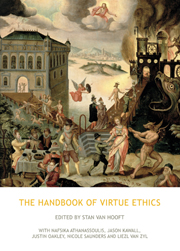Book contents
- Frontmatter
- Contents
- Acknowledgements
- 1 Introduction
- PART I NORMATIVE THEORY
- 2 Eudaimonia in contemporary virtue ethics
- 3 Stoic virtue ethics
- 4 Naturalistic virtue ethics and the new biology
- 5 Virtue ethics and moral sentimentalism
- 6 Virtue ethics and utilitarianism
- 7 Virtues and rules
- 8 Virtue ethics, virtue theory and moral theology
- 9 Nietzsche's virtue ethics
- 10 Right action and the targets of virtue
- 11 Qualified agent and agent-based virtue ethics and the problems of right action
- 12 The virtuous person and normativity
- 13 Virtue and identity
- PART II TYPES OF VIRTUES
- PART III APPLIED ETHICS
- PART IV THE PSYCHOLOGY OF VIRTUE
- Contributors
- References
- Index
10 - Right action and the targets of virtue
from PART I - NORMATIVE THEORY
- Frontmatter
- Contents
- Acknowledgements
- 1 Introduction
- PART I NORMATIVE THEORY
- 2 Eudaimonia in contemporary virtue ethics
- 3 Stoic virtue ethics
- 4 Naturalistic virtue ethics and the new biology
- 5 Virtue ethics and moral sentimentalism
- 6 Virtue ethics and utilitarianism
- 7 Virtues and rules
- 8 Virtue ethics, virtue theory and moral theology
- 9 Nietzsche's virtue ethics
- 10 Right action and the targets of virtue
- 11 Qualified agent and agent-based virtue ethics and the problems of right action
- 12 The virtuous person and normativity
- 13 Virtue and identity
- PART II TYPES OF VIRTUES
- PART III APPLIED ETHICS
- PART IV THE PSYCHOLOGY OF VIRTUE
- Contributors
- References
- Index
Summary
One of the central questions in normative theory is the question of what makes an action right: which quality (or qualities) must an action possess in order for it to be right? Consequentialism and deontology answer this question by making reference to consequences and duty respectively, so it seems that if virtue ethics is to be taken seriously as an alternative normative theory, it should provide an account of right action that is distinctive in some way. The most popular virtue-ethical theory of right action is the qualified-agent account developed by neo-Aristotelians like Rosalind Hursthouse (1999: 28):
(V): An action is right if and only if it is what a virtuous agent would characteristically do in the circumstances.
There is some disagreement over whether this criterion answers the question of what makes an action right: that is, whether it provides an explanatory account of right action as opposed to a merely substantive account (see Slote 2001: 4ff.; Sandler 2007: 91; Kawall 2009a; Crisp 2010). It is tempting to read (V) as stating (or implying) that it is the fact that an action would be done by a virtuous agent acting in character that makes it right. However, another interpretation of (V) is that it simply asserts that what all right actions have in common is that they are the kinds of actions that virtuous agents characteristically perform, and it does not necessarily follow that it is this feature that makes them right.
- Type
- Chapter
- Information
- The Handbook of Virtue Ethics , pp. 118 - 129Publisher: Acumen PublishingPrint publication year: 2013

